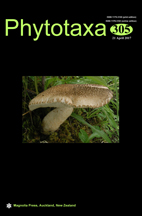Abstract
Caloneis mendosina var. mendosina, Caloneis mendosina var. minor and Caloneis quilinensis from slides of the Frenguelli Collection deposited at the Herbarium of the División Ficología ‘Dr. Sebastián A. Guarrera’ (LPC), were investigated using light microscope (LM). Unmounted material related to these slides was observed using the scanning electron microscope (SEM). Specimens of both varieties of C. mendosina found in the original material show a continuous range of size and stria density, and are ultrastructurally similar; thus the taxa are considered conspecific. Specimens of C. quilinensis found in the original material show more variability than described in the protologue. A continuous range of size, stria density, shape of the frustules and valve outline was observed between C. mendosina and C. quilinensis. Additionally, ultrastructural comparison of both taxa showed numerous features in common including shape of the valve surface, morphology of the valve mantle, shape of the axial area, shape of the fascia, position of the raphe, morphology and orientation of the external central and distal raphe fissures, and size and position of the elliptical apertures of the alveolate striae. The evidence that there is no morphologic and morphometric discontinuity between these Frenguelli taxa and that they come from similar diatomaceous earth deposits, justify considering them conspecific. Based on the principle of priority the correct name of the species is Caloneis mendosina. The description of C. mendosina was emended, a lectotype slide was selected, and a comparison with some allied species was conducted.

